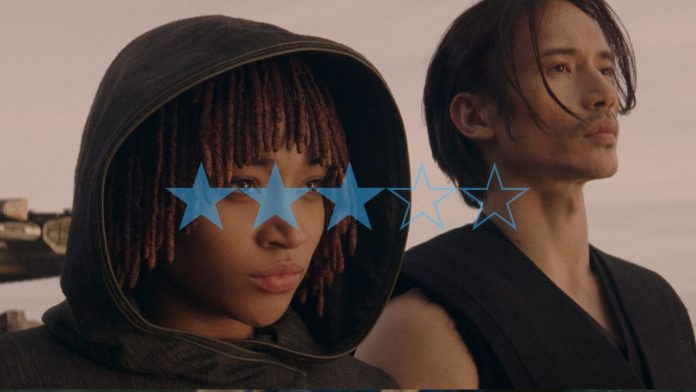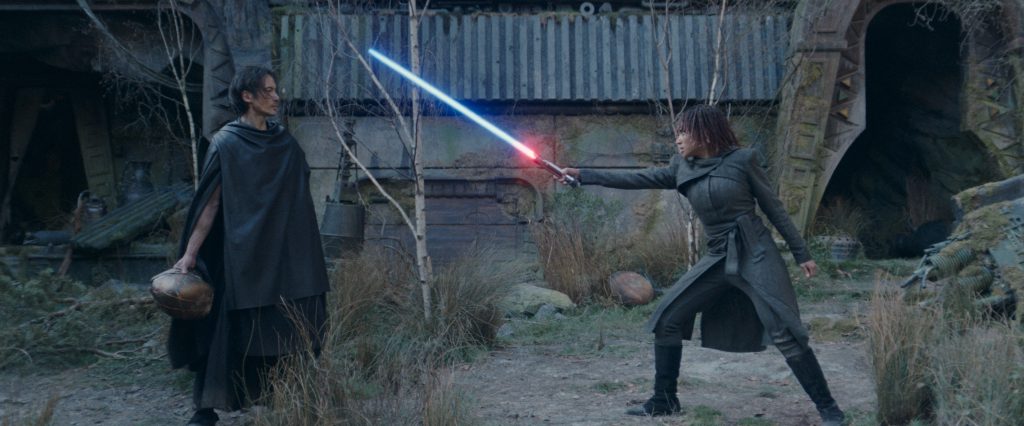
Recently, there has been a pattern for streaming platforms to limit their original series to six or eight episode seasons—particularly on Disney+—and while this format can pose an interesting challenge to creators to condense their story, not all of them are up to that challenge. This was true, unfortunately, for The Acolyte.
★★★☆☆
Spoiler Warning: This review contains spoilers for season one of The Acolyte.
The Acolyte is a Star Wars tale set at the end of the High Republic, therefore set before the events of all previous shows and movies. It follows a Jedi investigation into the murder of one of their own, which quickly dissolves into a pursuit of a serial killer who can use the force. Along the way, truths are unveiled and the line between good and evil becomes permanently blurred as uncertainty turns to violence.
I came into my viewing wanting, very much, to enjoy the show. I had liked The Mandolorian, loved Andor, and felt that this new show had amassed a very talented cast of people to tell its story: with Amandla Stenberg as Osha/Mae, Lee Jung-jae as Sol, Manny Jacinto as Qimir, Dafne Keen as Jecki, and Charlie Barnett as Yord in the main cast.
The first two episodes were almost magical, watching a new spin on this universe that fans adore, from a time period previously unexplored. Unfortunately, as I continued watching, I realized there was a big problem with the writing. It was obvious that the creators of this show wanted to tell a hefty story, and were not given much time to do so. But instead of cutting down repetitive and unnecessarily long scenes, the fix is using dialogue as a vessel for exposition. It’s the ‘telling not showing’ of filmmaking, and it made certain scenes a little stale. A great example of this taking place is in the beginning of episode one where Yord (Charlie Barnett) apprehended Osha (Amandla Stenberg) because the Jedi believed that she killed Indara (Carrie-Anne Moss). During his interrogation of her, he narrates close to her entire life story—a story she clearly knew. It was under the guise of him musing on her possible motives, but it’s thinly veiled, and an obvious quick-fix to establish that information early on.

Somehow, simultaneously I knew a lot of things that I didn’t care about, or could have inferred from context, and didn’t know anything about other things that I was extremely curious about. For example, we get two episode-long reenactments of the exact same moments, just slightly tweaked in order to show the difference between altered memories and reality. This, I believe, could have been done in much less time and allowed for more time to explore Qimir’s (Manny Jacinto) relation to the Jedi, or anything about the order of witches other than how they related to Osha and Mae, or building Yord’s character in any meaningful way before he was brutally killed. Because of this, at the end of the season, I was left wanting more. Although, at the same time, I had no inclination to rewatch and have to slog through those unnecessary scenes again.

That leads into another one of my qualms with the show: the character building. This aspect also suffers a bit from the ‘telling not showing’ approach to making of The Acolyte. In episode six, Mae, disguised as Osha, tells us this about our protagonist: “I had to lose a lot of myself in order to become a Jedi.” This statement seemed a little out of left field, as we never got a real look at who Osha was as she was training to become a Jedi. I think it would have been more impactful if we had been able to see this aspect of her personality build through action, rather than Mae telling us. Throughout The Acolyte, that’s what most of this boils down to, as with such a short amount of time to tell this story, the showrunners try to fit so much in such a small space that nothing packs the punch intended.
Another example of failed character building shows up when Yord dies. He appears in five of the eight episodes, and for one of those appearances, he is only a corpse. I was sad to lose the potential that his character held. After all, he stuck so steadfastly to the tenants of the Jedi order, so how would seeing the failures of the order change him? Grate on him? But, that was the only feeling that this scene evokes. Jecki (Dafne Keen) is similarly underdeveloped, though I appreciate her quick wit in the sequences we do see. And although it is disappointing to find she isn’t returning, it isn’t exactly heart-wrenching despite the time dedicated in trying to build her character thus far. Sol’s death hurt more, and Lee Jung-jae gave an incredible performance in his final moments, but even then, I was too caught up in my confusion about his relationship to Osha for me to focus on the scene unfolding. The entirety of his and Osha’s rapport is built in the flashbacks of Brendok, and through being told that he used to mentor her. There was potential for a devastating, almost familial betrayal in his death scene, but it just didn’t quite land.

I’ve laid down plenty of complaints, but the show had successes as well—namely the fight sequences. The choreography is fast-paced and well-executed, creating action which is believable and thrilling. Surprisingly, one of the most evocative scenes I watched of Jecki was where she fought Mae to try and apprehend her outside of Kelnacca’s hut. She uses everything available to her, fights hard and always gets back up. She manages to beat Mae, and the sequence told me more about her character than any throwaway line of dialogue in the past couple episodes has managed to. From this sequence, we find she’s resourceful, persistent, and level headed, even in life or death situations—a successful character-building action scene.
The Verdict
The showrunners did the best they could with the time they were given, and the fighting sequences showcased the compelling visual storytelling that they are capable of. I think, with more time to develop the characters and different, intersecting storylines, this show could be something I would re-watch. But as it stands now, it rushes the storyline and fails to hold my attention. Though not a bad show by any means, there is plenty of room for improvement.
Words by Marlee Gaitanis
Support The Indiependent
We’re trying to raise £200 a month to help cover our operational costs. This includes our ‘Writer of the Month’ awards, where we recognise the amazing work produced by our contributor team. If you’ve enjoyed reading our site, we’d really appreciate it if you could donate to The Indiependent. Whether you can give £1 or £10, you’d be making a huge difference to our small team.